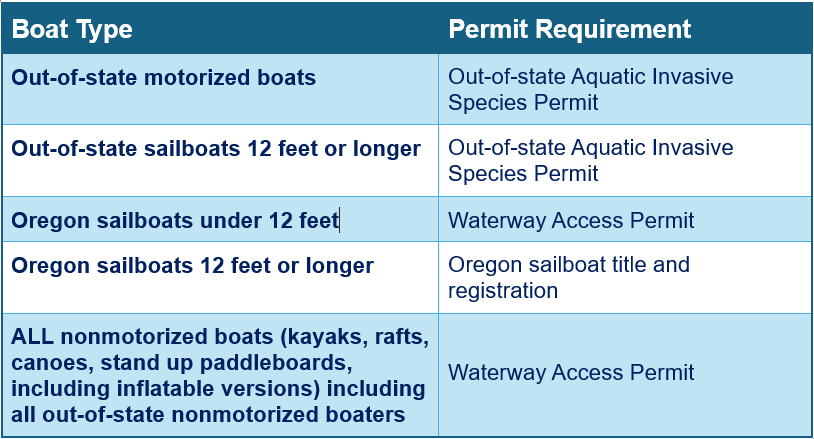Drain, Clean, Dry: Protecting Oregon’s Waterways
DRAIN water from your motor, live well, bilge, and inside compartments on land before leaving the waterbody. For paddlecraft, flip or tilt the craft to let the water drain. Open any compartments and remove seats if necessary. Rinse or flush under the flooring, at inflation chamber joints, or in other areas that can trap mud and debris.
CLEAN all aquatic plants,
animals, and mud from your boat, motor, or trailer and discard them in the
trash. Rinse, scrub, or pressure wash away from storm drains, ditches, or
waterways. Lawns, gravel pads, or self-serve car washes are best.
DRY your boat between uses if
possible. Leave compartments open and sponge out standing water. Find a place
that will allow the anchor line to dry. AND "Pull the Plug" if
your boat has a drain plug.
Study the pictures here and report any you find to the toll-free Oregon Invasive Species hotline: 1-866-INVADER.
ALSO:
Empty your bait bucket on land before leaving the waterbody. Releasing live bait, aquatic animals, or plants from one waterbody into another is illegal.
Paddlecraft and Out-of-State Motorized Boats require Permits
All boaters who operate paddlecraft, including inflatable versions of kayaks, rafts, and stand up paddleboards, will be required to stop for inspection and purchase a Waterway Access Permit. Failure to show the permit to law enforcement can lead to a $115 fine.
Are you an out-of-state visitor wanting to boat in Oregon? If you own an out-of-state motorboat or sailboat with an auxiliary motor, you need to buy an Aquatic Invasive Species (AIS) Prevention Permit. Out-of-state motorboat owners who do not have a $20 out-of-state AIS permit can be fined $50. Oregon motorized boaters must have valid registration decals displayed on their motorboats.
ORS 830.990: 1. Violation of ORS 830.565 by a person operating a sailboat 12 feet in length or a motorboat on the waters of this state without first obtaining an aquatic invasive species prevention permit is punishable by a fine of $50. 2. Violation of the requirement to carry a Waterway Access Permit is punishable by a fine of $115.

Visit: Boat.Oregon.gov/store to purchase a 7-day permit, annual permit, or two-year permit. ODFW also offers all three permit options.
Mandatory Boat Inspection Stations
All Boaters (transporting motorized or nonmotorized boats) are REQUIRED to stop if the inspection station is OPEN
Inspection teams are made up of specially trained personnel employed by the Oregon Department of Fish and Wildlife. ALL boaters are required to stop at designated roadside inspection stations.
Inspection teams will look inside and outside boats (including kayaks and canoes mounted on vehicle racks) for invasive species. Any area that is capable of storing water for extended periods of time is inspected.
Inspections take approximately 10 minutes. If a motorized boat passes inspection, the driver is given an inspection report. This is proof of compliance and is a receipt of the inspection. If a boat has any invasive species, the inspection team will decontaminate the craft on-site. This could take anywhere between 20 minutes to 1 hour. Inspectors will show the boater how to clean, drain, and dry the craft before launching it into Oregon waterways.
Inspection stations are set up at the points of entry into Oregon and also at random locations.
Failure to stop at an inspection station could result in a fine of $115 fine.
---
SECTION 1. ORS 570.855
570.855 (1) The State Department of Fish and Wildlife, the State Marine Board, and the State Department of Agriculture may require a person operating or transporting a recreational or commercial watercraft to stop at a check station for the purpose of inspecting the watercraft for the presence of aquatic invasive species:
[(b)] (2) The Department of Fish and Wildlife, the State Marine Board, and the State Department of Agriculture may decontaminate, or recommend decontamination of any recreational or commercial watercraft that is inspected at a check station operated under the authority of this section.
[(2)] (3) All check stations operated under the authority of this section must be plainly marked by signs that comply with all state and federal laws and must be staffed by at least one uniformed employee of the State Department of Fish and Wildlife, the State Marine Board or the State Department of Agriculture trained in inspection and decontamination of recreational or commercial watercraft.